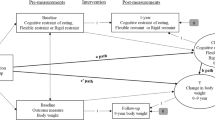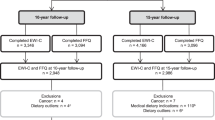Abstract
Objective:
To study the relationships between the Eating Inventory (EI) factors (restraint, disinhibition and hunger), body adiposity and prevalence of selected diseases in a quota sample of Czech adults.
Subjects and methods:
The sample included 1429 men and 1624 women who were interviewed individually by trained investigators. The sample was quota representative – for gender, age, size of residential location, region and socioeconomic status in Czech adults. Anthropometric data, socioeconomic and lifestyle information were obtained. Subjects filled out the EI questionnaire. Physicians reported about subjects’ morbidity.
Results:
Backward stepwise regression analysis revealed that restraint and disinhibition were significant predictors of body mass index (BMI) along with gender, age, parental obesity, weight loss attempts, present dieting and educational level. The same factors plus income predicted the waist circumference. BMI and waist circumference were negatively related to restraint but positively to disinhibition. According to logistic regression analysis restraint and disinhibition were significantly associated with hypertension, cardiovascular diseases and hyperlipidaemia. Diabetes was significantly related to restraint and hunger scores. The observed association between EI factors and diseases remained significant even when BMI and age were taken into account.
Conclusion:
As shown in earlier studies, disinhibition was positively and restraint negatively associated with BMI and waist circumference. For the first time, factors of the EI were also identified as significant predictors of diseases characterizing the metabolic syndrome.
This is a preview of subscription content, access via your institution
Access options
Subscribe to this journal
Receive 12 print issues and online access
$259.00 per year
only $21.58 per issue
Buy this article
- Purchase on Springer Link
- Instant access to full article PDF
Prices may be subject to local taxes which are calculated during checkout
Similar content being viewed by others
References
Stunkard AJ, Messick SM . The three-factor eating questionnaire to measure dietary restraint, disinhibition and hunger. J Psychosom Res 1985; 29: 71–83.
Baucom DH, Aiken PA . Effect of depressed mood on eating among nonobese dieting and nondieting persons. J Personal Soc Psychol 1981; 41: 577–585.
Herman CP, Polivy J . Anxiety, restraint, and eating behavior. J Abn Psychol 1975; 84: 666–672.
Polivy J, Herman CP . Effects of alcohol on eating behavior: Influence of mood and perceived intoxication. J Abn Psychol 1976; 85: 601–606.
Lawson OJ, Williamson DA, Champagne CM, DeLany JP, Brooks ER, Howat PM et al. The association of body weight, dietary intake, and energy expenditure with dietary restraint and disinhibition. Obes Res 1995; 3: 153–161.
Williamson DA, Lawson OJ, Brooks ER, Wozniak PJ, Ryan DH, Bray GA et al. Association of body mass with dietary restraint and disinhibition. Appetite 1995; 25: 31–41.
Stunkard AJ, Wadden TA . Restraint eating and human obesity. Nutr Rev 1990; 48: 78–86.
Canetti L, Bachar E, Berry EM . Food and emotion. Behav Process 2002; 60: 157–164.
Ruderman AJ . Restraint, obesity, and bulimia. Behav Res Ther 1985; 23: 151–156.
Wardle J . Dietary restraint and binge eating. Behav Anal Modif 1990; 4: 201–209.
Roemmich JN, Wright SM, Epstein LH . Dietary restraint and stress-induced snacking in youth. Obes Res 2002; 10: 1120–1126.
Bjorvell H, Rossner S, Stunkard AJ . Obesity, weight loss and dietary restraint. Int J Eat Disord 1986; 5: 727–734.
Delahanty LM, Meigs JB, Hayden D, Williamson DA, Nathan DM . Psychological and behavioral correlates of baseline BMI in the Diabetes Prevention Program (DPP). Diabetes Care 2002; 25: 1992–1998.
Laporte DJ, Stunkard AJ . Predicting attrition and adherence to a very low calorie diet: a prospective investigation of the Eating Inventory. Int J Obes Relat Metab Disord 1990; 14: 197–206.
Westenhoefer J, Stunkard AJ, Pudel V . Validation of the flexible and rigid control dimensions of dietary restraint. Int J Eat Disord 1999; 26: 53–64.
Foster GD, Wadden TA, Swain RM, Stunkard AJ, Platte P, Vogt RA . The Eating Inventory in obese women: clinical correlates and relationship to weight loss. Int J Obes Relat Metab Disord 1998; 22: 778–785.
Grilo CM . On the relationship of attempting to lose weight, restraint, and binge eating in outpatients with binge eating disorder. Obes Res 2000; 8: 638–645.
McGuire MT, Jeffrey RW, French SA, Hannan PJ . The relationship between restraint and weight and weight-related behaviors among individuals in a community weight gain prevention trial. Int J Obes Relat Metab Disord 2001; 25: 574–580.
Westenhoefer J, von Falck B, Stellfeldt A, Fintelmann S . Behavioural correlates of successful weight reduction over 3 years. Results from the Lean Habits Study. Int J Obes Relat Metab Disord 2004; 28: 334–335.
Drapeau V, Provencher V, Lemieux S, Despres JP, Bouchard C, Tremblay A . Do 6-y changes in eating behaviors predict changes in body weight? Results from the Quebec Family Study. Int J Obes Relat Metab Disord 2003; 27: 808–814.
Bellisle F, Clément K, Le Barzic M, Le Gall A, Guy-Grand B, Basdevant A . The Eating Inventory and body adiposity status from leanness to massive obesity: a study of 2509 adults. Obes Res 2005; 12: 2023–2030.
Hainer V, Kunesova M, Bellisle F, Hill M, Braunerova R, Wagenknecht M, STO Study Group. Psychobehavioral and nutritional predictors of weight loss in obese women treated with sibutramine. Int J Obes Relat Metab Disord 2005; 29: 208–216.
d’Amore A, Massignan C, Montera P, Moles A, De Lorenzo A, Scucchi S . Relationship between dietary restraint, binge eating, and leptin in obese women. Int J Obes Relat Metab Disord 2001; 25: 373–377.
Karlsson J, Sjostrom L, Sullivan M . Swedish obese subjects (SOS) – an intervention study of obesity. Two-year follow-up of health-related quality of life (HRQL) and eating behavior after gastric surgery for severe obesity. Int J Obes Relat Metab Disord 1998; 22: 113–126.
Bathalon GP, Hays NP, Meydani SN, Dawson-Hughes B, Schaefer EJ, Lipman R et al. Metabolic, psychological, and health correlates of dietary restraint in healthy postmenopausal women. J Gerontol Med Sci 2001; 56A: M206–M211.
Hays NP, Bathalon GP, Roubenoff R, Lipman R, Roberts SB . The association of eating behavior with risk for morbidity in older women. J Gerontol Med Sci 2002; 57: M128–M133.
Neale BM, Mazzeo SE, Bulik CM . A twin study of dietary restraint, disinhibition and hunger: An examination of the Eating Inventory (Three Factor Eating Questionnaire). Twin Res 2003; 6: 471–478.
Hainer V, Kunešová M, Parízková J, Štich V, Slabá Š . Prevalence and causality of obesity in central and eastern Europe. In: Ailhaud G, Guy-Grand B (eds). Progress in Obesity Research. J. Libbey: London, 1999, pp 653–663.
Cífková R . Prevention of ischaemic heart disease in adults. Joint guidelines of Czech professional societies. Diab Metab Endokrin Vyz 2001; 4: 13–27.
Westenhoefer J . Dietary restraint and disinhibition: is restraint a homogeneous construct? Appetite 1991; 16: 45–55.
Hays NP, Bathalon GP, McCrory MA, Roubenoff R, Lipman R, Roberts SB . Eating behavior correlates of adult weight gain and obesity in healthy women aged 55–65 years. Am J Clin Nutr 2002; 75: 476–483.
Tepper BJ, Ullrich NV . Influence of genetic taste sensitivity to 6-n-propylthiouracil (PROP), dietary restraint and disinhibition on body mass index in middle-aged women. Physiol Behav 2002; 75: 305–312.
Westenhoefer J, Pudel V, Maus N . Some restrictions on dietary restraint. Appetite 1990; 14: 137–141.
Lindroos AK, Lissner L, Mathiassen ME, Karlsson J, Sullivan M, Bengtsson C et al. Dietary intake in relation to restrained eating, disinhibition, and hunger in obese and nonobese Swedish women. Obes Res 1997; 5: 175–182.
Dykes J, Brunner EJ, Martikainen PT, Wardle J . Socioeconomic gradient in body size and obesity among women: the role of dietary restraint, disinhibition and hunger in the Whitehall II study. Int J Obes Relat Metab Disord 2004; 28: 262–268.
Muls E, Kempen K, Vansant G, Saris W . Is weight cycling detrimental to health. A review of the literature in humans. Int J Obes Relat Metab Disord 1995; 19 (Suppl 3): S46–S50.
Levy E, Levy P, Le Pen C, Basdevant A . The economic cost of obesity: the French situation. Int J Obes Relat Metab Disord 1995; 19: 788–792.
Corella D, Ordovas JM . The metabolic syndrome: a crossroad for genotype-phenotype associations in atherosclerosis. Curr Atheroscler Rep 2004; 6: 186–196.
Bouchard L, Drapeau V, Provencher V, Lemieux S, Chagnon Y, Rice T et al. Neuromedin β: a strong candidate gene linking eating behaviors and susceptibility to obesity. Am J Clin Nutr 2004; 80: 1478–1486.
Provencher V, Pérusse L, Bouchard L, Drapeau V, Bouchard C, Rice T et al. Familial resemblance in eating behaviors in men and women from the Québec Family Study. Obes Res 2005; 13: 1624–1629.
Hood MY, Moore LL, Sundarajan – Ramamurti A, Singer M, Cupples LA, Ellison RC . Parental eating attitudes and the development of obesity in children. The Framingham Children's Study. Int J Obes Relat Metab Disord 2000; 24: 1319–1325.
Stice E, Shaw HE . Role of body dissatisfaction in the onset and maintenance of eating pathology: a synthesis of research findings. J Psychosom Res 2002; 53: 985–993.
Lahteenmaki L, Tuorila H . Three-factor eating questionnaire and the use and liking of sweet and fat among dieters. Physiol Behav 1995; 57: 81–88.
Delparigi A, Chen K, Salbe AD, Reiman EM, Tataranni PA . Sensory experience of food and obesity: a positron emission tomography study of the brain regions affected by tasting a liquid meal after a prolonged fast. Neuroimage 2005; 24: 436–443.
De Lauzon B, Romon M, Deschamps V, Lafay L, Borys J-M, Karlsson J, et al., the Fleurbaix Laventie Ville Sante (FVLS) Study Group. The Three-Factor Eating Questionnaire-R18 is able to distinguish among different eating patterns in a general population. J Nutr 2004; 134: 2372–2380.
Steinle NI, Hsueh WC, Snitker P, Pollin TI, Sakul H, St Jean PL et al. Eating behavior in the Old Order Amish: analysis and a genome-wide linkage analysis. Am J Clin Nutr 2002; 75: 1098–1106.
Acknowledgements
This work was supported by Grants COST OC B17-40, IGA NR/7800-4 and by the Ministry of Health of the Czech Republic. The authors would like to thank Dr P Brezovský (Head of the Medical Care Department of the Ministry of Health of the Czech Republic) and Dr T Raiter (Head of the Stem/Mark – Centre for Sociological and Empiric Studies) for their support.
Author information
Authors and Affiliations
Corresponding author
Rights and permissions
About this article
Cite this article
Hainer, V., Kunesova, M., Bellisle, F. et al. The Eating Inventory, body adiposity and prevalence of diseases in a quota sample of Czech adults. Int J Obes 30, 830–836 (2006). https://doi.org/10.1038/sj.ijo.0803202
Received:
Revised:
Accepted:
Published:
Issue Date:
DOI: https://doi.org/10.1038/sj.ijo.0803202
Keywords
This article is cited by
-
The Three-Factor Eating Questionnaire-R21: a confirmatory factor analysis in a Portuguese sample
Eating and Weight Disorders - Studies on Anorexia, Bulimia and Obesity (2020)
-
Lifestyle intervention discloses an association of the Eating Inventory-51 factors with cardiometabolic health risks
Eating and Weight Disorders - Studies on Anorexia, Bulimia and Obesity (2013)
-
Psychometric analysis of the Three-Factor Eating Questionnaire-R21: results from a large diverse sample of obese and non-obese participants
International Journal of Obesity (2009)



